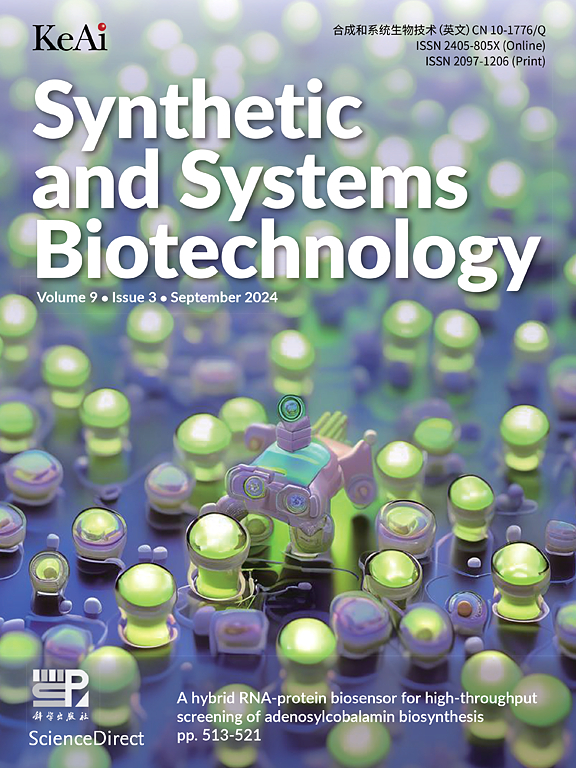dTSR enables efficient improvement of heterologous production of spinosad in Saccharopolyspora erythraea
IF 4.4
2区 生物学
Q1 BIOTECHNOLOGY & APPLIED MICROBIOLOGY
引用次数: 0
Abstract
Spinosad (spinosyns A and D) is a highly effective and environmentally friendly insecticide widely used for pest control. However, the difficulty of genetic manipulation in the original strain, Saccharopolyspora spinosa, has hindered improvements in fermentation yields using synthetic biology methods. Additionally, there is a lack of simple and effective methods for enhancing the production of polyketide natural products derived from slow-growing rare actinomycetes. In this study, we developed a doubly transposition and site-specific recombination (dTSR) approach to insert bacterial attachment sites (attB) and two copies of spinosad biosynthetic gene cluster (spn BGC) into various chromosomal locations of Saccharopolyspora erythraea, thereby generating heterologous production strains for screening of spinosyn producers with improved yields. Engineered strains from the first round of TSR breeding produced spinosad at levels ranging from 5.6 to 30.5 mg/L. The second round of TSR breeding produced engineered strains with increased yields, with the highest spinosad production reaching 137.1 ± 10.9 mg/L. These results indicated that (1) the dTSR approach could efficiently generate initial heterologous strains with significantly improved spinosad production, and (2) the dTSR approach enabled random integration of a second copy of spn BGC into various chromosomal locations in Sac. erythraea, thereby further increasing heterologous spinosad production to high levels. This study provides a simple, rational, and efficient approach to improve the heterologous production of polyketide natural products in rare actinomycetes.
dTSR 能够有效提高红藻糖孢菌异源生产尖孢霉素的能力
Spinosad (spinosyns A和D)是一种高效环保的杀虫剂,广泛用于害虫防治。然而,遗传操作的困难,原菌株,糖多孢子菌spinosa,阻碍了提高发酵产量使用合成生物学方法。此外,还缺乏简单有效的方法来提高从生长缓慢的稀有放线菌中提取聚酮类天然产物的产量。在这项研究中,我们建立了双转位和位点特异性重组(dTSR)方法,将细菌附着位点(attB)和两个spinosad生物合成基因簇(spn BGC)拷贝插入到Saccharopolyspora erythraea的不同染色体位置,从而产生异源生产菌株,用于筛选产量更高的spinossyn生产菌株。第一轮TSR育种的工程菌株产生的spinosad水平在5.6至30.5 mg/L之间。第二轮TSR育种获得了产量提高的工程菌株,最高的spinosad产量达到137.1±10.9 mg/L。这些结果表明:(1)dTSR方法可以有效地产生初始异源菌株,显著提高了spinosad的产量;(2)dTSR方法可以将spn BGC的第二拷贝随机整合到Sac的不同染色体位置。从而进一步将异源棘糖的产量提高到较高水平。本研究为提高稀有放线菌中聚酮类天然产物的外源生产提供了一条简单、合理、高效的途径。
本文章由计算机程序翻译,如有差异,请以英文原文为准。
求助全文
约1分钟内获得全文
求助全文
来源期刊

Synthetic and Systems Biotechnology
BIOTECHNOLOGY & APPLIED MICROBIOLOGY-
CiteScore
6.90
自引率
12.50%
发文量
90
审稿时长
67 days
期刊介绍:
Synthetic and Systems Biotechnology aims to promote the communication of original research in synthetic and systems biology, with strong emphasis on applications towards biotechnology. This journal is a quarterly peer-reviewed journal led by Editor-in-Chief Lixin Zhang. The journal publishes high-quality research; focusing on integrative approaches to enable the understanding and design of biological systems, and research to develop the application of systems and synthetic biology to natural systems. This journal will publish Articles, Short notes, Methods, Mini Reviews, Commentary and Conference reviews.
 求助内容:
求助内容: 应助结果提醒方式:
应助结果提醒方式:


